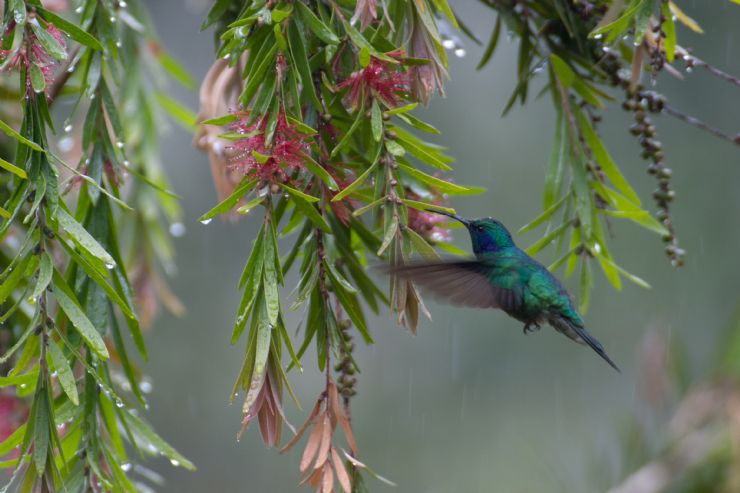
Green Violet-ear Hummingbird in Monteverde Reserve
If you’ve ever read anything about Costa Rica, then you’ve heard about the stunning array of wildlife that calls this country home.
Even today there are mysterious creatures that live undiscovered in the forests of Costa Rica.
One of the main reasons that so many animals are attracted to Costa Rica is because of Costa Rica’s weather.
Habitat plays an important in an animal’s choice of home, and in Costa Rica, animals like birds are lucky enough to be able to find the perfect seasonal or permanent home just by flying across the country. This fact makes Costa Rica the natural choice for many avian species.
I love to look up and see one of the many beautiful birds that call Costa Rica home flying along.
While there is so much to look at on the ground and at eye level in my country, it is nice to know that you can see even more beauty in the skies. Birds are a presence in Costa Rica year round, too. No matter where you go and what time of the year you plan Costa Rica vacations, you'll see beautiful birds flying up above.
Here are my favorite species to watch:
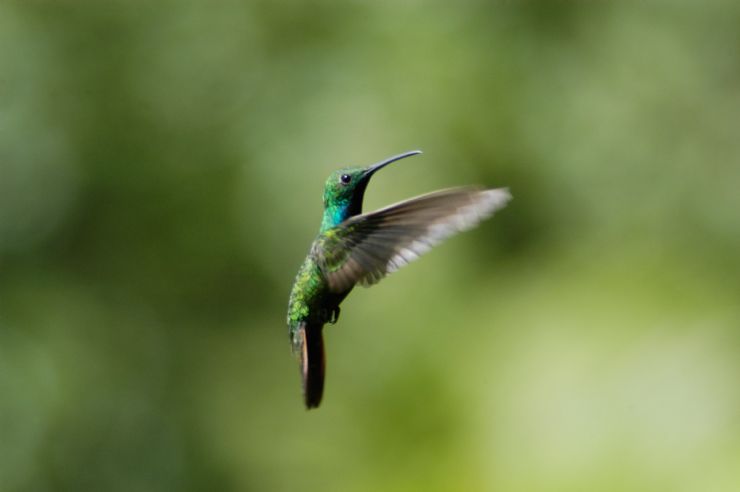
Hummingbird in Drake Bay
1. Hummingbirds
Hummingbirds are very common in Costa Rica, and can be seen all across the country. All you have to do is know what to look for: the right feeders or the right flowers and plants.
There are many different species of energetic hummingbirds in Costa Rica too – over 50 on record – so you are likely to cross paths with many different kinds, ranging in vibrant colors and sizes.
Some of the species to watch for include the blackcrested coquette, longbilled hermit, bandtailed barbthroat, copperyheaded emerald, Green Violet-ear Hummingbird, and the fiery-throated hummingbird. Each species of hummingbird is different; sometimes the males and females are distinct, and sometimes they are indistinguishable.
Hummingbirds are so common in Costa Rica, that there is even a Hummingbird Garden in Selvatura Park, in Monteverde. Whether you are a novice or experienced bird watcher, or just a curious soul, this is a great place to get amazing photos.
There aren’t just birds to photograph either, the forests and the waterfalls are amazing.
Another great place to see hummingbirds is at La Paz Waterfall Gardens, in Vara Blanca near Poás Volcano. Here, you can spot over 20 species of hummingbird while you stand near the feeders that attract them.
Hummingbirds are not afraid of humans, so you’ll be able to get an upclose look at these stunning creatures.
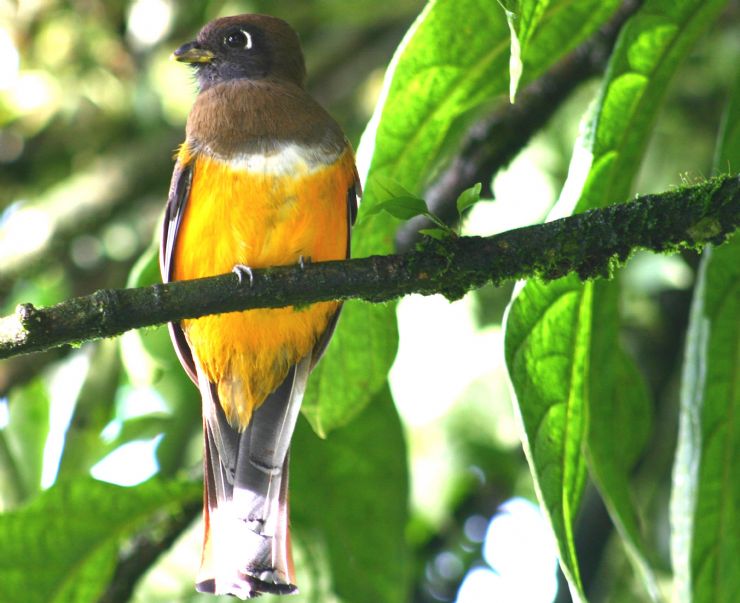
Orange Bellied Trogon in Cerro de la Muerte, Cartago
2. Trogons
Trogons might seem like a weird word and a strange choice to name a species of bird, but once you know more about these creatures, you’ll see that the name fits.
While these birds are stunning to look at, their name is more attached to how they gnaw their nests from rotted wood. They don’t have strong bills, but they have managed to find a way to build their nests for their families.
These birds are most vocal in spring and summer, and there are at least 10 species that you can spot while visiting my country. Some of the species you can spot include the gartered trogon, the blackheaded trogon, the slatytailed trogon, and the orangebellied trogon.
Head to one of the many national parks in Costa Rica to spot these stunners. One of the most important places to spot Trogons is Cerro de la Muerte.
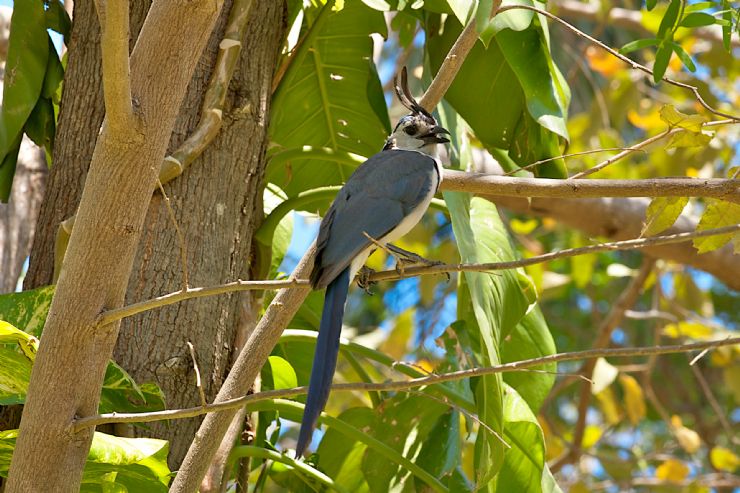
White-Throated Magpie-Jay in tree in Santa Rosa National Park
3. White-Throated Magpie-Jay
These birds are not shy. They travel in large groups, and they are loud. White-Throated Magpie-Jays are a large bird, and they can be spotted on the Nicoya Peninsula and in Santa Rosa National Park.
They have a great look, with a very long tail, and feathers on the head that are slightly curved. These birds do not migrate, and can be found in areas like forests, but also in cultivated areas like the many plantations for coffee that you will find throughout Costa Rica. Their diet consists of frogs, as well as eggs, fruit and nectar, but they are still wonderful to spot and watch!
Arenal Volcano National Park is also a popular hot spot for this beautiful birds
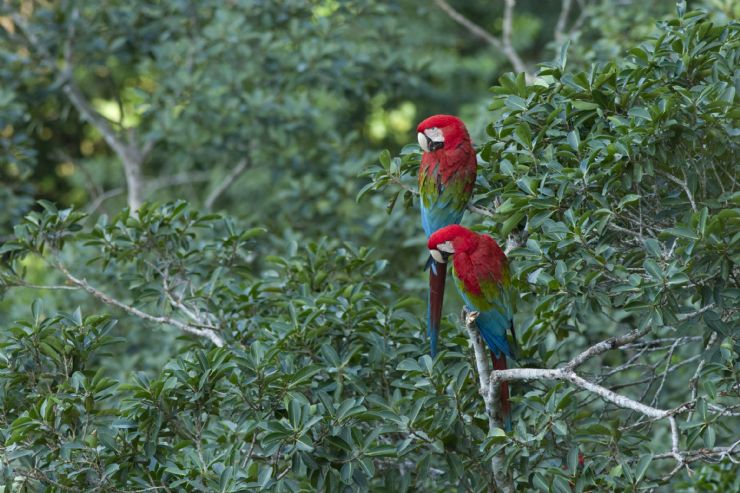
A pair of Scarlet Macaws (Ara macao) in a tree on the Osa Peninsula
4. Scarlet Macaw
Scarlet Macaws are easily one of the most vibrantly colored species on the planet, which makes them very easy to recognize. You definitely don’t have to be an experienced bird watcher to spot these beauties! Their bright red, yellow, blue and green feathers make these birds one of the most striking of any breed of parrot.
These birds are not only colorful, but they are sizable too! From the top of their heads to the tips of their tails, scarlet macaws can be as long as 33 inches.
This breed tends to fly with friends, so you may see a group of loud and brightly colored macaws in places like Corcovado National Park, Palo Verde National Park and Carara National Park.
They usually reside high up in the canopy in tall trees or mangroves. Be sure to keep looking up, and to bring along your binoculars, to get a closeup look at these wonderful creatures.
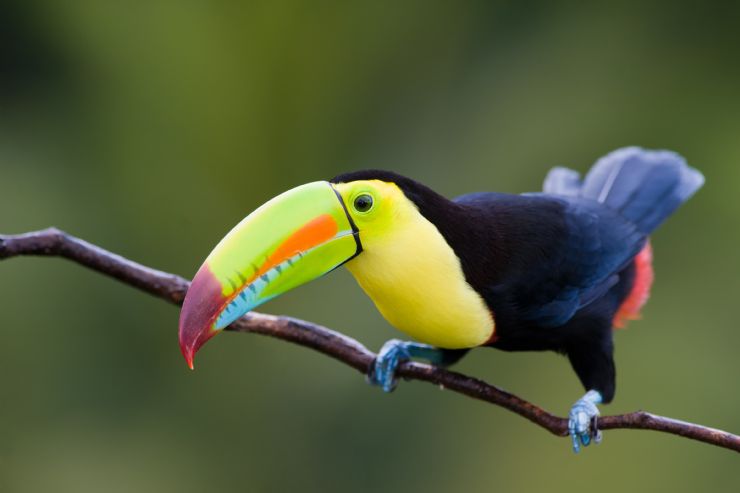
Keel Billed Toucan preparing to fly on forest
5. Keelbilled Toucan
The keelbilled Toucan is another bird that is easy to recognize. This species is most wellknown for its beak, which is long and colorful.
This Toucan is even sometimes referred to as the rainbowbilled toucan because of the progressive colored pattern on its beak. While the beak is beautiful, it is also functional; the birds use it to pick berries.
If you are traveling within the Monteverde Cloud Forest Biological Reserve, La Selva Protected Zone & Biological Station or Tortuguero National Park, you are likely to see keelbilled Toucans traveling in small flocks.
Sometimes, when I know I am in Toucan territory, I like to try to listen for them rather than look for them; this species likes to sing songs, like crickets! Whether you are excited to get a glimpse of that rainbow beak, or you’re excited to hear a Toucan sing for you, spotting this bird in the wild will surely be quite the experience.
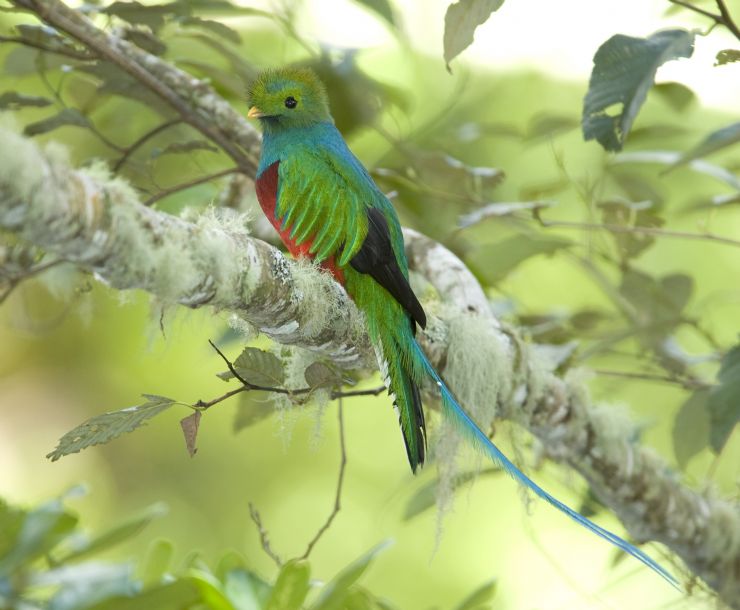
Amazing Quetzal with its wonderful colors
6. Resplendent Quetzal
Costa Ricans are proud that the resplendent quetzal calls their country home, and from shore to shore this bird is known to be one of the most beautiful in Costa Rica.
This comes as no surprise to me at all; I’ve traveled all around this country and seen some of its most beautiful sights, but this bird captures my attention every time with its bright green back, deep red belly and prominent feathers. I love finding the most unique creatures to be my friends, and the resplendent quetzal is definitely unique.
One of the most interesting things about them is that their bodies are small, but their tails are very long. I’m also so proud that they call Costa Rica home, since their population is not large.
They live in other places as well, but your chances of spotting one are highest in Costa Rica. They tend to live up in the canopies where they nest and search for food. Chirripo National Park, Braulio Carrillo National Park, Poas Volcano National Park and Monteverde Cloud Forest Reserve are all home to the quetzal.
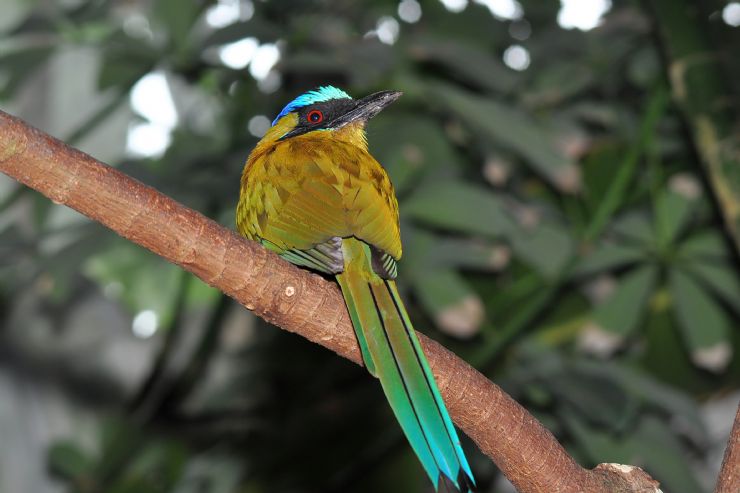
A Blue-crowned Motmot in Curú Wildlife Refuge
7. Bluecrowned Motmot
I told you that I like to find the most unique creatures around, and the bluecrowned motmot fits into that category very well.
There are five other species of motmot that call Costa Rica home as well, and while the bluecrowned motmot is a tiny bird, it stands out from the other species in Costa Rica because it has a uniquely colored head, a green body, and a long tail.
This particular species of the Motmot is the most common in my country, and can most likely be found in Santa Rosa National Park, Carara National Park and Manuel Antonio National Park.
They can be seen in trees near the forest floor, about 13 feet from the ground.
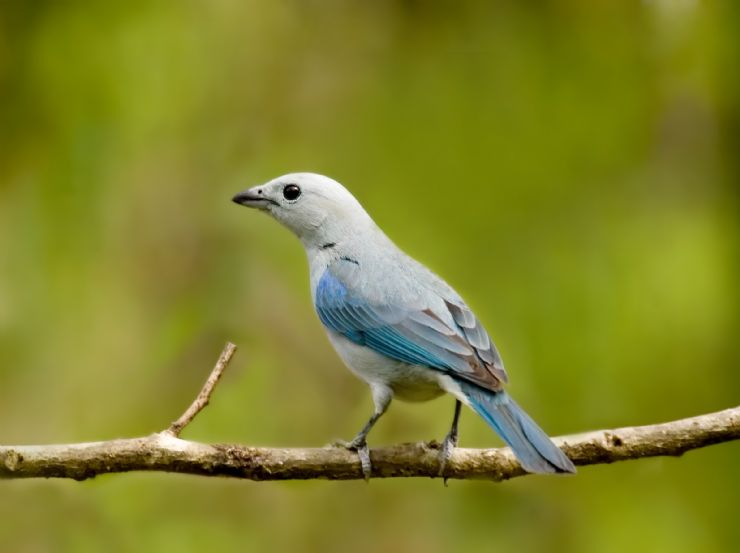
Beautiful Blue Tanager at Poas Volcano National Park, Alajuela
8. Bluegray Tanager
The bluegray tanager is one of my favorite species because they have proven to be so adaptable.
Though this little bird is common, it is also unmistakable with its small stature and grayblue hue. This bird can be found in the lowlands to middle elevations, and it has adapted well to both dry and humid forests.
My favorite part about this bird is that you don’t even have to go to a nature reserve to spot them; they also live in urban settings and normal parks and gardens across the country.
You’ll most often see them in pairs, feasting on the fruit from the many trees and vines in Costa Rica. You won’t spot them in one place for too long though, as these are a restless species. I don’t blame them though, there is a lot to see in my beautiful country. It is fairly likely that you’ll spot a bluegray tanager during your stay in Costa Rica, so be sure to bring your camera!
Which bird species have you, or are you hoping to, see in Costa Rica?
There are so many amazing creatures here that it was hard for me to pick just a few! No matter where you visit in Costa Rica, you’ll be delighted by all of the wildlife that you experience.

